This week we've been running a 5 day workshop with a class of 30 nine year olds in Year 4 at the Jenny Hammond Primary School with our friend and collaborator Loren Chasse. The workshop focused on 'everyday archaeology' – a term we're using to describe investigations of the local environment using a combination of Feral Robots, Urban Tapestries, Sound Scavenging, an Endless Landscape, StoryCubes and eBooks.
Over the course of the week we have been using everyday archaeology to teach the students about relationships between the environment and pollution. The students have been acting as scientists and archaeologists to gather evidence about the world around them to uncover causes of pollution. This has been a trigger for them to imagine what they could do to help the environment and think about the kind of world they want to grow up in. The students gathered audio recordings, photographic evidence and used the Feral Robots to detect air quality in a local park, wrote stories based on the Endless Landscape, designed their own robots and created structures and environments using the StoryCubes. The workshop covered a range of key skills and concepts from map reading, making media, storytelling, drawing and literacy to more abstract concepts, science and maths – an intense and broad immersion for the students, teachers and for us.
As we begin to evaluate the project, we have been inspired by the willingness of the students to engage, learn and share their experiences, as well as with the teaching staff who have woven our processes and tools into their own teaching. The excitement of the children has been infectious, not only for us, but across the whole school, including the staff. We hope now to develop a longer term collaborative process of weaving our tools, concepts and processes into the core teaching and learning methods used in the school.
Update: The Activity and Impact Report on the Workshop is available to download.
The project is also featured as a case study on the London Schools Arts Service website.
Last Saturday we spent the afternoon with HIRO on the Havelock estate interviewing locals about their experiences of living there – the things they were positive about and the problems they face. The aim of the interviews is to produce a DVD of 'Havelock Voices' that presents a range of different people's stories and experiences. This can then be the touchstone for locals to record their own stories using the media resources (digital video camera, digital editing software etc) that are available at HIRO (including an iMac and WiFi Meshbox loaned by Proboscis). One avenue we're exploring for Havelock in particular is place-based audio streaming from Urban Tapestries that can be broadcast locally using AM or low-power FM. We think this way we might begin to address the key question of how people who are not part of the digital revolution can still be part of the knowledge mapping and sharing it envisages. Not everybody has a computer or internet access, but almost everyone has a radio.
Based on the interviews and the past year of discussions with residents we've also created two StoryCubes which aim to put the issues into the palm of people's hands and stimulate further discussion of their own experiences. We are planning a workshop this summer to encourage residents to make their own cubes with images of the good things about Havelock and the problems they face. By building up a set of StoryCubes made by different people, we hope we can start to connect many more of the stories and challenges experienced by residents, which can then become a trigger for mapping them using Urban Tapestries.
Proboscis is working with St Marks Short Life Housing Co-op as part of Social Tapestries to explore how a transient housing community (transient in terms of membership and property) shares and captures knowledge. St Marks is a small housing co-op with a current membership of 17. It has properties primarily in West London and works with a number of Housing Associations across several London Boroughs to provide housing for its members.
Proboscis organised a mapping session at the Venture Community Centre as an opportunity for members of St Marks to come together and collectively share their individual histories and explore the collective history of the co-op. Former members of St Marks were also invited to participate in this event but unfortunately none were able to attend. This workshop was the second we have run with the co-op – a previous one in June 2005 explored the local connections that co-op members have made to the area it is based in and how the kinds of knowledge they have could be shared online.
The members were presented with a series of maps covering the areas of London where (as researched so far) the co-op has had properties over the last 25 years. Current and former properties were mapped back on to this map, annotated with memories associated with living in these locations and interacting with other co-op members.
Many stories added to the maps related closely to how members have collaborated in the past to cope with the difficulties presented by living in short life housing. Assistance with moving, cleaning and repairing properties to make them fit for habitation highlighted the positive co-operative actions of members and were recounted in several different stories. The natural sense of community when living close by to other St Marks members also came out as a positive and made co-operative values and behaviour more natural on a day to day level.
Discussion touched on key issues concerning how the co-op operates, its structure and key issues it faces. The importance of group decision making was highlighted, and whilst sometimes time consuming is key to the democratic principles of the co-op. Each member has an equal vote and voice on all issues.
Managing short life property, St Marks is often faced with properties on the edge of acceptable living standards either through state of repair, location or security. Security is currently an important issue for St Marks and the co-op has begun to work with an outside agency (the police) to try and come to a solution.
Technology such as email is changing how the co-op communicates and making it easier where members do not live within close proximity (an older member recounted how when she first joined minutes from meetings were hand delivered). However, email has it’s own problems and cannot replace the discussions and democratic decision making process referred to above. Initially Proboscis has been using Google Earth as an introduction to the concept of public authoring for St Marks which was enthusiatically taken up by co-op members as a possible way of capturing and sharing St Marks' history. The next stage will be to offer co-op members the opportunity of using the Urban Tapestries platform.
For Proboscis the exercise was an opportunity to work with and experience St Marks as a group, to complement and build on information gathered through eBooks and individual interviews. This will contribute to a knowledge sharing of the history of St Marks Housing Co-op between Proboscis and St Marks, working towards a way of enabling the Co-op to gather and retain knowledge in the future to compensate for the transient nature of the organisation's membership.
Documentation from the workshop on pollution mapping in London Fields held at SPACE in November 2005 is available to download here as an A4 DIFFUSION eBook.
Thursday also saw Proboscis participate in another key partner's open day. We have been developing a Social Tapestries collaboration with a primary school in Waltham Forest (North East London). The school is going through a re-development phase, re-designing their building and embedding creativity into every aspect of school life – an extremely inspirational and visionary approach. Once again our colleagues at Getmapping.com have provided us with a high resolution aerial photo of the school and its catchment area, which we were able to show to parents and students and to discuss the aims of integrating the public authoring approach with the school curriculum. The response both from parents and students was very favourable, with quite a few of the parents being particularly interested in how they could become involved. Getting this kind of investment from not just teachers and students but parents too is going to be critical in creating a programme that is not an extra burden on everyone, but deeply integrated into the everday life of the school.
Proboscis have been invited by the school to work with them on designing ways in which our vision of public authoring, knowledge mapping and sharing can be integrated into the everyday learning and teaching methods. This is based on the experimental programme we designed last year for Kingswood High School in Bransholme, Hull – where students would map phenomena in their everyday environment to be used as material in each of their classes. For instance, students mapping and recording different dialects spoken in their family / community for an English language class would use the same data in their History class to explore the social history of their community, and in their Geography class to investigate social movement and change. The same data might also be used in a Maths class to look at pattern and distibution theories.
Our initial collaboration with the school has been through environmental sound mapping workshops with artist Loren Chasse, a sound artist and educator from San Francisco, with whom we have been collaborating on Sound Scavenging. During the summer we ran a week-long workshop with students from Year 5 to investigate and capture sounds in their environment. A second workshop next month will focus on mapping their recordings and exploring the relationships to people, places and things which these suggest. This kind of associative learning is intended to make the process of learning and sharing itself proximate and directly relevant to student's life and the places they live, work and play in. Our vision is to investigate how we might use public authoring to increase the sense of ownership students have in the learning process – using phenomena in their own world that they have collected and generated (and 'own') instead of always having to revert to examples in text books. By siting the place of learning within their own everyday experience and enviornment we hope to make it more tangible, especially for students in areas of deprivation and lack of opportunity where school and learning might seem remote and irrelevant.
An important milestone in developing the Community Collaboration projects for Social Tapestries was passed today when we participated in an open day organised by the Havelock Independent Residents Organisation (HIRO) for the local residents of the Havelock Estate in Southall, Ealing. Earlier this summer Proboscis and Kevin Harris of Local Level were invited by HIRO to come and discuss our ideas for knowledge mapping and sharing and how this could help them in their project (funded by the ODPM) to create a tenant management organisation and take over the management of their estate from Ealing Homes (HIRO are being assisted in the process by community development worker Bev Carter at Partners in Change). Since then we have been developing tools and practices that are appropriate to the site and situation.
Over 40 local residents (including many children) turned up at the HIRO office today to find out more about what's happening to their community and to share their problems, hopes, stories and knowledge about the estate and the environment. Our partners at Getmapping.com had kindly made a very high resolution aerial photograph of the area available to us which we printed as a 5 foot square table-top map. Throughout the afternoon people annotated the map and took away special DIFFUSION eNotebooks to record their feelings about aspects of the estate and to start to collect comments and stories about specific places.
Over the next six months or so we hope to run a series of participatory events with the local residents to build a up a (publicly authored) knowledge base of evidence about everyday life in the area. We aim to learn more about their technological needs and capabilities so that we can design tools and techniques for them to capture and and re-present their knowledge and experience via platforms like Urban Tapestries. Ultimately we hope to learn from these collaborations to create platforms that truly enable and empower people to map and share their knowledge of their community and environment in ways that help them improve the opportunities open to them.
Update
Kevin has blogged a piece about the event which captures just how much we learnt from listening to the residents and, how important and sensitive the role of the listener is.
15 people attended the workshop (mostly locals but including a few others from outside the locality with a specific interest in pollution sensing) and the event generated a broad discussion and exploration of not only the local factors affecting London Fields, but also the wider social and cultural perceptions of what it means to measure and map pollution. We'll post some documentation summarising the event's outcomes online soon.
Our next step is to build, with Birkbeck College, our own Feral Robot that can capture sensor data from several types of sensor (Gasoline and Diesel Exhaust, Alcohol, TUolene, Xylene) with location information (GPS) and upload to the Urban Tapestries system. We're hoping to test the prototypes before Xmas and document the project in a small publication (as well as online) by March 2006.
The Feral Robot in the image above is one of Natalie Jeremijenko's built (by Matt Karau) for the Save the Robots festival at The Ark in Dublin during this summer. The map used in the workshop was a high resolution aerial photo of London Fields and surrounding area, kindly provided by Getmapping.com.
Some Links:
London Air
Your Air
DEFRA Air Quality site
Air Quality archive
UCL City Project
Equator: Urban Pollution Monitoring project
Stanza: Sensity Project
Public Air Quality Indicator
European LIFE programme
The Vienna Air Monitoring Network
Sensing Pollution in London Fields
Wednesday 9th November, 2-5pm
Space Media Arts, 129-131 Mare Street E8 3RH [map]
Proboscis is running a Bodystorming workshop to map some of the known and visible pollution issues in and around London Fields. We will use this to explore the invisible pollution issues – air quality, historic industrial pollution etc – that may not be obvious. We will demonstrate a ready-made Feral Robot and experimental sensors we are developing with Birkbeck College that can upload sensor traces to the Urban Tapestries public authoring system. The Guardian published a short article on the Feral Robots: Robots with a nose for trouble.
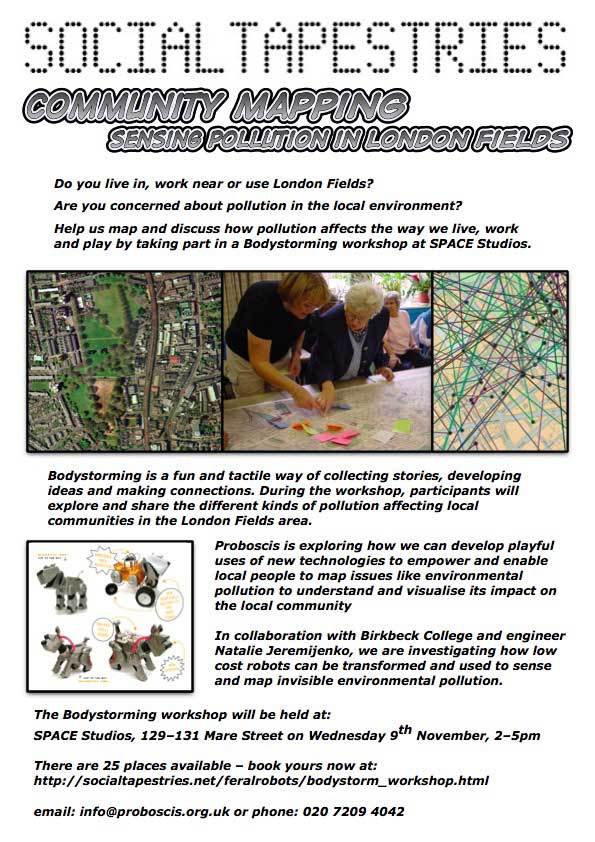
There are 25 places available on the workshop for local residents, workers and users of London Fields. If you live or work in, or use London Fields and would like to participate, please sign up here. We particularly welcome people who are neither artists nor technologists, but who are simply interested or concerned about local pollution and would like to participate in imagining new ways of taking action.
On another note we (somewhat belatedly) finished the documentation from our last Creative Lab on Social Tapestries held at the LSE in September. It includes a section on the Bodystorming Experience we ran as part of the event.
Download the DIFFUSION eBook (A4 PDF 333Kb).
Via SpaceandCulture we have yet more proof that industry can directly benefit from working with artists by learning new processes and methodologies that can be directly translated into their own practices.
Intel's Ken Anderson and UC Berkeley's Jane McGonigal have presented a paper on "Place Storming" at NordiCHI 2004 that claims to be "an original method of brainstorming technological concepts, particularly in the area of pervasive computing". Wow.
Its amazing to us that Ken can make this claim considering that one of his research team took part in one of our own Bodystorming Experiences back in May 2003, he attended a talk I gave on Bodystorming Experiences and other techniques we use at the People Inspired Innovation Conference in September 2003 at BT Exact to an audience of specialists in the pervasive computing field, and that we have been disseminating our outputs and documentation from Bodystorming Experiences back to him and other colleagues at Intel over the past few years.
Proboscis has always been clear in distinguishing our specific development of Bodystorming Experiences from the more general practice of bodystorming (which we first learned about via IDEO) but to call Place Storming an original method? Its not even an original appropriation of an idea – HP Labs got there first with their Model Storming.
Last Thursday Proboscis organised a one day Creative Lab at the London School of Economics exploring the theme of 'public authoring and civil society'. The Lab brought together participants from range of organisations, including (among others) Citizens Online, Community Development Foundation, Learning & Skills Council, Ordnance Survey and the University of Cambridge.
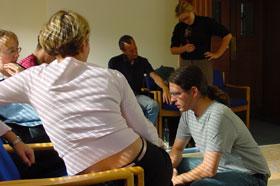
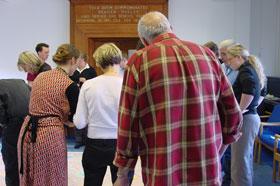
During the morning we brainstormed uses and scenarios for knowledge mapping in civil society. In the afternoon we bodystormed some of these ideas within the context of education, community arts, housing & local government interactions.
We'll be documenting the outcomes of the day over the next 2 weeks and producing an eBook to summarise the issues, ideas and scenarios arising from the day. We'll use this to help guide the development of future collaborations and experiments withing the Social Tapestries research programme.
On May 15th, I gave a presentation on Urban Tapestries and conducted a Bodystorming at the PsyGeo Conflux in New York City -- fun!! (see thumbnails below). The conference was an interesting contrast to the recent spate of European gatherings that seemed to present "locative media" as some kind of spinoff/sibling/offshoot of new media. Maybe due to the context of being in the middle of the Lower East Side art scene, there was much more "psychogeography" than cutting-edge high-tech.
Thus there was a human chess game on the streets of Williamsburg, a 24-hour road trip throughout the 5 New York boroughs, musings on the history of dérive and the flâneur, and a great talk by Peter Lamborn Wilson on his methodology in exploring the forgotten sacred backwaters of North America.
Don't get me wrong -- digital goodies were still alive and well at the Conflux! An outstanding example was the One Block Radius project presented by conference organizers Christina Ray and Dave Mandl. Over the course of several months, they obsessively documented one square block that will be the new site of the New Museum of Contemporary Art.
Their project made me realize that we really have to tackle the hard problems of filtering and scaling if we're going to build a functional, urban-wide annotation system. They show ONE block annotated by TWO people -- what happens when you open up the annotations to all comers? And then what happens when you scale up from one block to one city?? Mindboggling possibilities! Check it out.
(photos by Christina Ray - Click to enlarge)
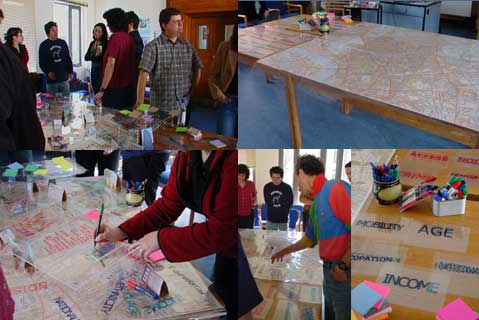
As part of our ongoing research into the social and cultural uses of 'public authoring' via pervasive mobile technologies we held a new Bodystorming event around broad issues of 'neighbourliness', at the LSE last Friday. An invited group of 10 people took part from civil society, technology research, creative, artistic and academic backgrounds, interested in investigating the social and cultural potential of emerging mobile technologies in social situations.
The participants were:
Will Davies (iSociety), Steve Dietz (Freelance Curator), Gordon Gow (Media@LSE), Kevin Harris (Community Development Foundation), Michelle Kent (Creative Partnerships Hull), Laurence Kovacocy (France Telecom R&D), Joyce Majiski (artist, Canada), Graziano Milano (The Public), Sherrie-Lee Samuel (Ordnance Survey), Loz Wilson (Kingswood School, Hull).
It was facilitated by Alice Angus, Giles Lane, Sarah Thelwall & Nick West (Proboscis) and Victoria Peckett & Zoe Sujon (Media@LSE).
The event sketched out the various boundaries, barriers and parameters of 'communities' within a defined geographic area, and explore how technologies like Urban Tapestries might be used to transcend them for social and cultural benefit.
Dividing into three groups, we each explored one of the three issues of; neighbourliness, social capital in the public commons and community reportage; thinking about how a system like UT might be used to transcend boundaries and barriers within these contexts.
The aim of the event was partly to help identify key issues with possible future collaborators, as well as existing ones, and will feed into our plans for the Social Tapestries research project. Building on this event we will also be creating a new bodystorming experience for the creative lab in June.
A special eBook of the outcomes of the Bodystorm is available here.
Proof that industry can directly benefit from working with artists by learning new processes and methodologies that can be directly translated into their own practices:
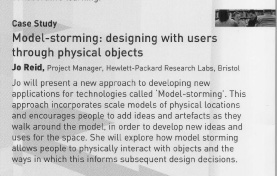
Our partners at HP Labs have profited from taking part in our Bodystorming Experiences – adopting the model for use in their own projects. Jo Reid will be presenting their version (Modelstorming) at NESTA futurelab's Digital Dialogues Event, Sheffield 24-25 March 2004.
A few days back Rachel and I had a fabulous and triumphant day bodystorming with the lovely ladies from Marchmont Community Centre.
Unfortunately no kids turned up - so we are going to rethink that one and my suggestion to them was to wait until January and then do a project using the technology or mocks up of it and find a group of kids or school who'd like to do a project that involves the older people.
We made some funky pop ups for the map and Rach collected props to spark memories - like a ration book. There were some amazing threads and discussions created and it was a really enriching experience. Some of the participants were born here and have lived here for more than 80 years, others have come from as far away as Jamaica, they had the most incredible life stories, wisdom, knowledge and knew all kinds of unusual things about the city.
They are a really sharp bunch and talk about their lives and how politics and attitudes and meanings have changed - so it becomes more about revealing the social history and ideas of people that are linked to a place and a discussion is inspired by the memories linked to a place - rather than a story about a location. For example one of the discussions began about life during the war in a specific street in Bloomsbury and around St Clements Danes Church and then developed into the impact different governments have had on peoples lives. Another discussion about the hospitals, then the erradication of TB and how that altered society and then the whole issues of changes in medicine.
And lastly another discussion came up when we were looking at Soho, about the changes in sexual attitudes and ideas of what sexual freedom really is. Some of them were so frank and open - it was very generous.. It has made me think about a few ways to present how UT might be used - new scenarios.
I want to take this a step further and to also make something tangible for the community centre to keep. So I am proposing:- making a smaller map just of the area most of them lived in, mounted on a noticeboard that we hang in the centre, and over the next 4 weeks people annotate it - this means they can add photos and images as well - they agreed to that idea.
Then we will do a final event in November with the large map looking at all the histories and stories that have been collected and I thought I'd make those stories visible - like with pop ups and the advent calendar idea. I'll make diffusion ebooks of all of them and I also would like to compile everything into one handmade album of all their stories for the community center.
I also met someone there who is the Mission Worker for the local United Reform Church and is trying to set up an oral history intergenerational project. She thought UT was excellent and seemed keen to work with us she also had a suggestion of a school teacher we should approach to do some work with school kids.
The most important part of our day however is that Rachel won a giant bag of bite sized mars bars in the centre raffle. It was interesting because she spied them earlier in the day and said she wouldn't mind having those. The with it became clear they are in the raffle we bought tickets and she won them - so she much have great powers of attraction. Also we get tea and shortbread and italian biscuits after the event - how many focus groups do you do where you get fresh tea and shortbread brought to you, a raffle and some excellent ladies to chat with.